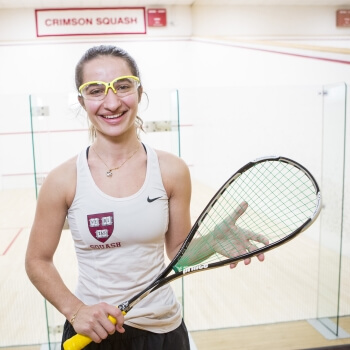News
Keegan Mendez, A.B. '17, a biomedical engineering concentrator, also plays on the Harvard Women's Squash Team. (Photo by Eliza Grinnell/SEAS Communications.)
This sky-diving, squash-playing, thrill-seeking student is gearing up for her next great adventure—in biomedical engineering research and discovery.
Why did you decide to concentrate in biomedical engineering?
As a child, I always had a love of math and science, and I liked to use my hands to create things—I shunned Barbie dolls for building blocks. I was already a math and science nerd, but what appealed to me about bioengineering specifically is the breadth and diversity of research options, from organs on a chip to medical device design, and everything in between. The research that is happening right now—like trying to grow a human heart outside the body—is so cutting-edge and exciting.
Tell us about some of the bioengineering research you’ve had the opportunity to conduct at SEAS.
During my sophomore year, I began working in David Mooney’s lab on developing the TheraCardium, which is a cardiac device for stem cell delivery to the heart for patients who have suffered a heart attack. The device supports regrowth of the damaged tissue and helps to prevent scarring of the dead heart muscle, in an effort to help prevent future cardiac events.
Mendez works on a biomedical research project in the Mooney lab. (Photo by Eliza Grinnell/SEAS Communications.)
Why was that research experience beneficial for you?
By working on that project, I experienced many different types of research, from preclinical studies in animals, to tissue engineering, to the materials science involved in building the device, to various soft robotic manufacturing techniques. I had the opportunity to work with many new technologies that I hadn’t been exposed to in the classroom.
What is the topic of your senior thesis project?
Drawing on my work on the TheraCardium, I am designing a soft robotic drug delivery system. The device involves a hydrogel adhered to a soft robotic balloon that could be placed on the surface of the heart to directly delivery therapy to the muscle. Inflation of the balloon stretches the mesh size of the hydrogel, enabling delivery of the drug encapsulated within the hydrogel. By controlling the balloon inflation, we can achieve radio control, or the ability for on-and-off delivery. The device could also incorporate multiple balloons, delivering different drugs to separate areas of the heart.
In addition to your dedication to academics and research, you’ve also played on the Harvard Women’s Squash team. How did you get involved with that sport?
I started playing squash competitively when I was 8 years old. The neighborhood where I grew up had one of the best junior squash programs in the country. I was inspired by my older sister, Haley, who is a great squash player. She was recruited to play squash at Harvard. When it came time for me to apply to college, the coach told me he had used all his recruiting spots, but if I could get into Harvard, I could play, too. It all worked out, and I’ve been on the team for the past four years. There is a big mental aspect to squash. Your tactics and shot selection become critically important at the college level, since all the players are very technically proficient.
Are you and your older sister squash rivals?
We’re a very competitive family. When we play board games, it gets so competitive it is almost scary. Haley has always been better than I was on the squash court, but we still play all the time. We are definitely competitive academically, as well, and while I love squash, I feel like my true passion lies in academics.
When playing squash at the college level, tactics and shot selection become incredibly important, Mendez said. (Photo by Eliza Grinnell/SEAS Communications.)
Do you think academics will play a role in your future plans?
Definitely. I am planning to apply for Ph.D. programs in bioengineering, and Harvard is my first choice. I’ve been really excited about the research I’ve been able to do as an undergraduate, and I want to continue contributing to science and advancing the field. The projects I’ve been working on are just so cool, and I want to keep my research momentum going.
How do you feel that SEAS has prepared you for your future?
Beyond learning the technical skills—like how to code and use machines—being able to work closely with my peers on teams has given me a lot of confidence. As an engineer, you need to be able to communicate ideas effectively to people who may not be engineers. Collaboration is key within engineering, with each team member contributing an important piece to the puzzle. I have also been humbled, and learned when to ask for help, when to seek out peers, and when to work collaboratively in groups as opposed to attempting to do everything myself.
Name: Keegan Mendez
Class: 2017
Hometown: Brooklyn, N.Y.
Concentration: Biomedical Engineering
Hobbies: Hiking, biking, being outdoors, adventure activities
Fun fact: She recently checked skydiving off her bucket list. Her to-dos include climbing Mt. Everest and completing an Iron Man.
Mendez Profile
Topics: Bioengineering
Cutting-edge science delivered direct to your inbox.
Join the Harvard SEAS mailing list.
Press Contact
Adam Zewe | 617-496-5878 | azewe@seas.harvard.edu



